Hidden secrets of County Clare
You have seen all the major sights of Co.Clare? Here a few suggestions to follow if you like it more quiet.
Find a map with our suggestions → here
(Please be aware, by clicking on the map links you consent to data processing by Google. The full maps open in a new window.)
Explore from Ennis
- Killone Abbey
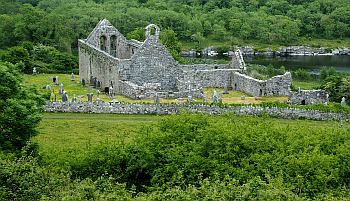
The Augustinian nunnery from the 12th century is located about 15 mins. southwest of Ennis in a secluded area bordered by woodlands and overlooking Killone Lake. The abbey contains some fine Romanesque features, such as the east windows and vaulted crypt. To get there drive to the little parking area off the N68 or R473 (see map. Nearby is St. John's well and a visit there should not be missed. From Killone continue along the Shannon on the scenic drive to Kilrush (see below) - Dromore Woodland Nature Reserve
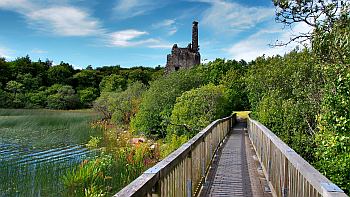
Lakeshore and woodland walks through Dromore Woodland Nature Reserve passing the ruins of Killakee Church, the shores of Lough Garr, Dromore Lough and the imposing O'Brien Castle. Picnic area and toilets available. (see map - Clare Abbey
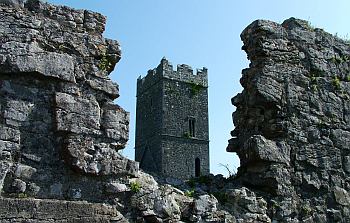
Clare Abbey lies on the west bank of the river Fergus, one km south of Ennis and north of the village of Clarecastle. It was founded in the twelfth-century and was once one of the most important monasteries in the diocese. You can reach it off the roundabout between Ennis, Clarecastle and the M18. - Kilmacduagh Monastery
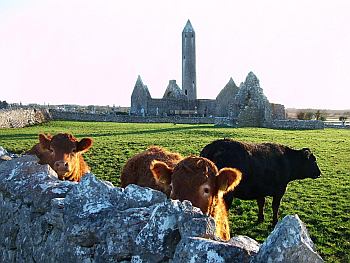
Kilmacduagh Monastery is located a few kms outside the town of Gort, just north of the Clare/Galway border in Co.Galway. The original monastery was founded by St Colmán in the 7th century. The site was later re-established as an Augustinian Abbey in the 13th century. The buildings today include a number of Churches, a slightly leaning Round Tower, and a Cathedral. You can find the abbey near the R460, southwest of Gort and north of Tubber, Co.Clare. The monastery is part of the Lady Gregory & Yeats Heritage Trail, which incorporates important historical sites between the towns of Gort and Loughrea in Southeast Co.Galway.
Southwest
- A scenic drive along the Shannon

A drive along the Shannon on the R473 brings you through the pretty, quiet villages of Ballynacally and Kildysart to Labasheeda. From there head back via Gortglass Lake to Kildysart or follow the R473 and R486 to Kilrush. > see map.
Northwest
- Dysert O'Dea

Dysert O’Dea Castle and its surrounding 25 original Archaeological field monuments are a must see on any visit to Clare. The authentically restored 15th century Dysert O’Dea castle, the stronghold of the O’Dea clan, houses the Clare Archaeology Centre. Dysert O’Dea Church, which stands on the site of an early christian monastery, dates mainly from the 12th century. Its most famous feature is the Romanesque Doorway. Near the church’s north western corner stands the remains of a Round Tower. The High Cross, situated east of the church, dates from the 12th century and is one of the finest examples of its kind in Ireland. The Archaeology/History Trail features 25 sites all within a few kilometres radius of the castle. A guide is available at the souvenir shop. Guided trail tours by prior arrangement. - Ennistymon & the falls

This town is often passed by on the way to/from the Cliffs of Moher, though it has a lot to offer on a short visit. Especially after rain the falls are very impressive and should be your first stop. Then walk through the streets with the colorful shop fronts and finish your walk at the graveyard above town. Friendly cafés and restaurants invite on the way back. - Corcomroe Abbey
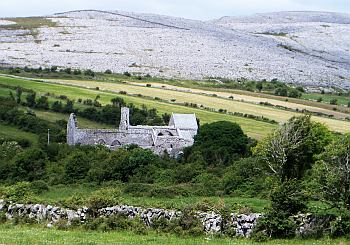
Corcomroe Abbey is dating back to the 12th century is named "Sancta Maria de Petra Fertilis", or Mary of the Fertile rock which describes its position in a sheltered, fertile green valley of the Burren, surrounded by bare grey limestone mountains. Evidence of earlier religious settlements are found close by in the deserted churches at Oughtmana, suggesting a long history of ecclesiastical life in this once remote valley. Corcomroe Abbey is signposted from the Wild Atlantic Way at Bellharbour. And while you're in the area also visit the Flaggy Shore beach, described by the late great poet Seamus Heaney - Cahercommaun Triple Fort

Cahercommaun sits on the edge of an inland cliff facing north overlooking a wooded valley, with three concentric walls reaching to the cliff edge. The inner wall alone used 16,500 tons of stone and forms an almost complete circle, but the two outer walls (connected with each other by subsidiary walls, like a fan) only form a semicircle. The innermost wall contains three chambers within the wall. The 20 min. walk starts on a small parking at the small direct road between Killinaboy and Carron. Some interesting megalithic tombs can also be found along this road.






